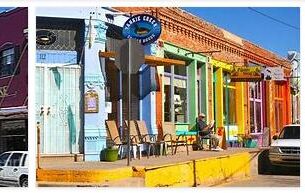At the northeastern tip of Newfoundland, in L’Anse aux Meadows, the only Viking settlement in America to date has been discovered. These are the first traces of European settlement on the continent. Two houses were reconstructed true to the original. It is not certain whether it is Leif Eriksson’s expedition, the settlement was only inhabited for a short time.
Viking settlement of L’Anse aux Meadows: facts
| Official title: | Historical National Park (Viking settlement) “L’Anse aux Meadows” |
| Cultural monument: | Reconstruction of a Viking settlement using excavation finds, formerly three groups of turf-covered wooden buildings, houses and workshops for seafaring boat builders, blacksmiths and carpenters who probably spent the winter here |
| Continent: | America |
| Country: | Canada, Newfoundland |
| Location: | at Black Duck Brook, Epaves Bay |
| Appointment: | 1978 |
| Meaning: | the first traces of European settlement in North America |
| About history: | 10/11 Proof of settlement through Nordic artifacts, including a simple bronze ring needle 7 cm in length |
| 1960-68 | Discovery and first excavations |
| 1973-76 | further excavations by Parks Canada with 2000 individual finds |
Where Leif Erikson set foot on American soil
In the far north of Newfoundland, the chirping of birds in the morning is mixed with a strange crunch and groan. The last ice floes of the long winter rub against each other under the summer sun. Even the beacons are switched off as long as the coast is not navigable – even today, often well into July; no easy conditions for the men who, almost a thousand years ago, were the first Europeans to set foot on the soil of the New World in what is now L’Anse aux Meadows.
The archaeologists were very surprised when they came across the remains of a Viking settlement here in 1960. The role that “Kommissar Zufall” plays for criminalists fell here to a fisherman who made the Norwegian historian couple Helge and Anne Stine Ingstad aware of small, artificial hills directly on the coast, which the locals use for long-abandoned living and living Burial place of the aborigines were kept.
The Ingstads discovered the hull of a ship there, the remains of houses that were covered with turf, cooking stoves and wrought-iron utensils, including anvil and nails – verifiably from a time when metalworking was still unknown in North America: this was the oldest Viking settlement in North America to date? A bronze needle with a ring at the end provided the final certainty. These needles were used by the Vikings to hold their cloaks together and were found many times during excavations in Scandinavia and Greenland. Presumably this Viking settlement is Leifbudir, the legendary landing site of Leif Erikson, the son of Erik the Red.
On the voyage from Iceland to Greenland, a storm struck the Viking Bjarni Herjolfsson in unknown waters in 986. After a long odyssey, he finally reached Greenland and talked about a previously unknown country – probably Newfoundland and Labrador. About ten years later, Leif Erikson followed in his footsteps and set off with 35 men far away from his home in search of an unexplored piece of earth on the Atlantic.
According to neovideogames, the historians dispute whether Newfoundland is the legendary “Vinland” from Viking tradition that Erikson claims to have discovered. It can be ruled out that this was Greenland. The Arctic is too hostile to life to think of “Vin” – of “Wine”. The comparatively fertile Newfoundland, on the other hand, is lush green in summer. However, viticulture is not possible there either. Newer interpretations decipher the Viking word “Vin” as “fertile”: If that is true, Newfoundland could well be the legendary “Vinland”, of which Viking reports since the beginning of the 11th century herald.
In L’Anse aux Meadows three Viking buildings, a house, a workshop and a stable, were reconstructed, which offer an insight into the way of life of the Nordic seafarers. Wooden scaffolding is covered with peat and turf, which insulate the house well against storms and cold. Buttercups bloom on the roofs. Narrow, wood-lined openings let in daylight. Fireplaces heat it from the inside.
In the footsteps of Erikson, who – according to tradition – is said to have stayed in Vinland for a year, other daring seafarers followed – most recently the men around Thorfinn Karlsefni. In Icelandic lore, “Vinland” was mentioned for the last time in the 14th century, while Leifbudir had already disappeared in the dark of time. Nonetheless, L’Anse aux Meadows – pronounced “Länsoh Miedohs” in broad English rather than French in today’s Newfoundland – proves that Europeans set foot on North American soil a few centuries before Columbus.



